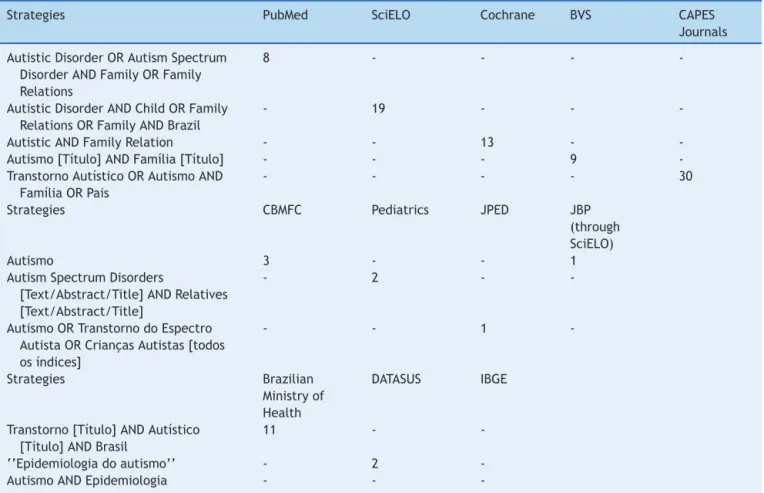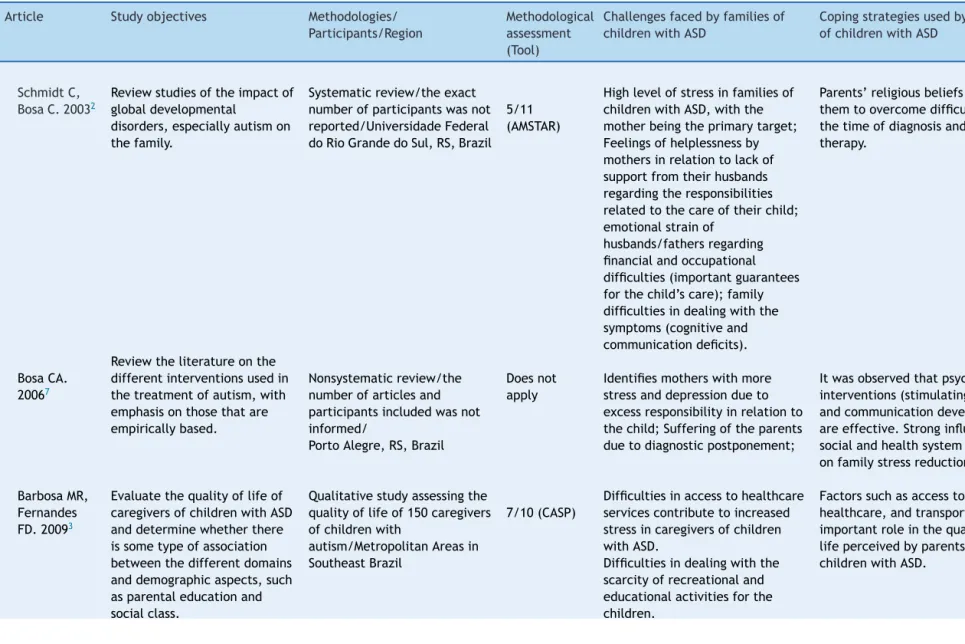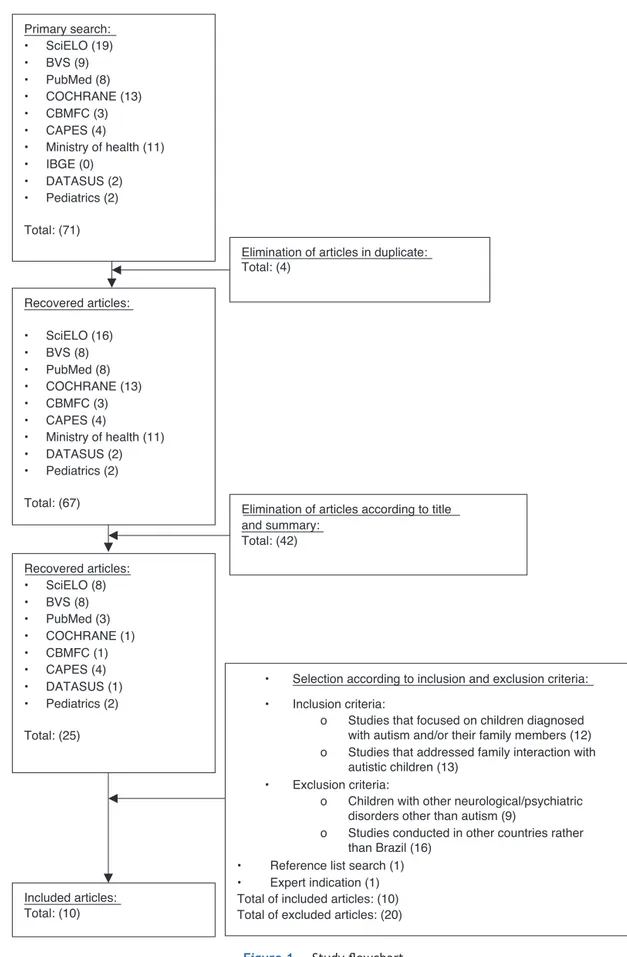JPediatr(RioJ).2015;91(2):111---121
www.jped.com.br
REVIEW
ARTICLE
Autism
in
Brazil:
a
systematic
review
of
family
challenges
and
coping
strategies
夽
,
夽夽
Paulyane
T.M.
Gomes
a,
Leonardo
H.L.
Lima
a,
Mayza
K.G.
Bueno
a,
Liubiana
A.
Araújo
b,
Nathan
M.
Souza
c,∗aFaculdadedeCiênciasMédicas,UniversidadeJosédoRosárioVellano(UNIFENAS),BeloHorizonte,MG,Brazil
bDepartmentofPediatrics,EscoladeMedicina,UniversidadeFederaldeOuroPreto(UFOP),OuroPreto,MG,Brazil
cDepartmentofCollectiveHealthandFamilyandCommunityMedicine,EscoladeMedicina,UniversidadeFederaldeOuroPreto
(UFOP),OuroPreto,MG,Brazil
Received18August2014;accepted27August2014 Availableonline10December2014
KEYWORDS
Autisticdisorder; Autism;
Familyrelations; Caregivers; BrazilianUnified HealthSystem
Abstract
Objective: Todescribethechallengesfacedbyfamiliescaringforchildrenwithautismspectrum
disorder(ASD)inBrazilandthecopingstrategiesemployed.
Sources: SystematicreviewofarticlespublisheduntilSeptemberof2013, withoutlanguage
restrictions,usingqualityappraisal(AMSTARandCASP/Oxfordinstruments).
Summaryofthefindings: Theliteratureshowsparentalemotionaloverloadasoneofthemain
challengesfacedbyfamilies,especiallymothers.Themainstressorswerediagnostic postpone-ment,difficultydealingwiththediagnosisandassociatedsymptoms,andpooraccesstohealth services and social support.The predominant coping strategiesfound included information exchangebetweenaffectedfamiliesandintegratedhealthcarenetworkforpatientandfamily support.
Conclusion: ASDexerts stronginfluenceonfamilydynamics,resultingincaregiveroverload,
especially inmothers.TheBrazilian UnifiedHealthSystemneedstoprovidecomprehensive, continuous,andcoordinatedcaretostrengthenthepatient-familydyadandpromotethefull developmentandsocietalinclusionofchildrenwithASD.
©2014SociedadeBrasileiradePediatria.PublishedbyElsevierEditoraLtda.Allrightsreserved.
夽
Pleasecitethisarticleas:GomesPT,LimaLH,BuenoMK,AraújoLA,SouzaNM.AutisminBrazil:asystematicreviewoffamilychallenges andcopingstrategies.JPediatr(RioJ).2015;91:111---21.
夽夽
StudyconductedatUniversidadeJosédoRosárioVellano(UNIFENAS),BeloHorizonte,MG,Brazil ∗Correspondingauthor.
E-mails:nathanmendes@hotmail.com,nameso@gmail.com(N.M.Souza).
http://dx.doi.org/10.1016/j.jped.2014.08.009
112 GomesPTetal.
PALAVRASCHAVE
TranstornoAutístico; Autismo;
Relac¸õesFamiliares; Cuidadores;
SistemaÚnicode Saúde
AutismonoBrasil,desafiosfamiliareseestratégiasdesuperac¸ão:revisãosistemática
Resumo
Objetivo: Descreverosdesafiosencontradospelasfamíliasnaconvivênciacomcrianc¸as
por-tadoras de transtorno do espectro autista (TEA) no Brasil e as estratégias de superac¸ão empregadas.
Fontedosdados: Revisão sistemática da literatura com inclusão de artigos publicados até
setembrode2013,semrestric¸õesdeidioma.Osartigosincluídosforamsubmetidosàavaliac¸ão dequalidademetodológicaatravésdoAMSTAReCASP/Oxford.
Síntesedosdados: Inclui-seestudosprovenientes deSãoPauloeRioGrandedoSulcomalta
emoderadaqualidademetodológica.Aliteraturamostrasobrecargaemocionaldospaiscomo um dosprincipaisdesafiosencontradospelasfamílias, inclusivecomgrandetensãosobreas mães.Dentreosfatoresrelacionadosao estresseestão:postergac¸ãodiagnóstica,dificuldade delidarcomodiagnósticoecomossintomasassociados,acessoprecárioaoservic¸odesaúdee suportesocial.Dentreasestratégiasdesuperac¸ãodestacaram-se:trocadeinformac¸õesentre asfamíliasafetadaseassistênciaintegralizadadarededesaúdenoatendimentodopaciente esuporteàfamília.
Conclusão: Observou-sequeoTEAexerceforteinfluêncianadinâmicafamiliarcomsobrecarga
doscuidadores,geralmentedamãe.OSistemaÚnicodeSaúdenecessitaprovercuidado inte-gral,longitudinalecoordenadovisandoofortalecimentodobinômiopaciente-famíliaeopleno desenvolvimentoeinserc¸ãodestascrianc¸asnasociedade.
©2014SociedadeBrasileiradePediatria.PublicadoporElsevierEditoraLtda.Todososdireitos reservados.
Introduction
Autistic spectrum disorder (ASD) is a neuropsychiatric syndrome characterized by behavioral manifestations accompaniedby deficits insocial interactionand commu-nication,repetitiveandstereotypedbehaviorpatterns,and arestricted repertoire of interestsand activities.1 Devel-opmentalabnormalities arealso characteristic of autism, whichcanbedetectedinthefirstthreeyearsoflifeand per-sistintoadulthood.2Despiteitsimportance,theetiologyof ASDremains unknown. It is believed tobemultifactorial, associated withgenetic and neurobiological factors, i.e., physiologicaloranatomicalabnormalityofthecentral ner-voussystem,innateconstitutionalproblems,andinteraction betweenmultiplegenes.2,3
Autism represents a pervasive developmental disorder of utmost importance due to itshigh prevalence. World-wideepidemiological data estimate that one in every 88 livebirthshasASD,affectingmoremalethanfemale individ-uals.InBrazil,in2010,itwasestimatedthatapproximately 500,000individualshadautism.3
ThediagnosisofASDisessentiallyclinical,attainedbased onobservationsofthechild,parentalinterviews,and appli-cationof specifictools. Thecriteriausedtodiagnose ASD are described in the Diagnostic and Statistical Manual of theAmericanPsychiatricAssociation(DSM).4Thesecriteria haveevolvedovertheyears.TheDSM-V,launchedinMayof 2013,isthenewesttooltoguidemedicaldiagnosisof indi-vidualswithASD.1,5InadditiontotheDSM-V,thereareother screeningtestsforASD,suchastheChildhoodAutismRating Scale (CARS), the Clinical Risk Indicators for Early Child-hoodDevelopment, and the ModifiedChecklistfor Autism inToddlers.3,6
Childhoodautism involves severe and early changes in the areas of socialization, communication, andcognition. The resulting scenariosare usuallysevere and persistent, withlarge individualvariations,butoftenrequiring exten-sivecareandpermanentcommitmentsfromthefamilies.7
ParentsofchildrenwithASDarefacedwithanew situa-tionthatrequiresfamilyadjustment.Thefantasizeddesire ofpregnancymustbeadjustedtotheindividualwhoisborn, and who has his/her own characteristics.8 Children diag-nosedwithASDoftenexhibitagreaterdegreeofcognitive impairmentanddifficultyininterpersonalrelations. Conse-quently,theyrequirespecialcare,includingadaptationsin formaleducationandupbringingasawhole.
Theseparticularitiesleadtochangesinfamilydynamics, requiringcarefulandprolongedcarebyallfamilymembers who livewitha child with ASD.Thus, increasedlevels of stressarefrequentlyreported,whichcanimpactthequality oflifeofallfamilymembers.9,10Thechild’sspecialcondition requiresthatparentsfacethelossoftheidealizedchildand developcopingstrategiestodealwiththenewreality.The interactionofparentswithspecificmanifestationsofASDin theirchildrencanoftenleadtothefamily’smarginalization regardingsociallife.8
In2013, the Brazilian Ministry of Healthpublished the GuidelinesfortheCareandRehabilitationofIndividualswith ASD,inordertoguidehealthprofessionalsaswellasfamily membersintheearlyidentificationofautisminchildrenas youngas3yearsofage.11
AutisminBrazil:systematicreview 113
2002and2009;amongthese,only21articlesmade refer-encetothecommunicationskillsofchildrenwithASDand theirinteractionwiththeirfamilies.Thissamestudy demon-stratedthattheBrazilianscientificproductiononASDdoes notmeetthecountry’sdemand.
ConsideringthepsychodynamicconceptualizationofASD andrecognizingthecomplexityofthefamilysituation,the present study consistsof asystematic review ofscientific literatureonthechallengesexperiencedbyfamiliesof chil-drenwithASDinBrazilandthestrategiesusedtoovercome thesechallenges.
Methods
This studyperformed asystematic review ofscientific lit-erature on the challenges faced by families living with and caring for children with ASD in Brazil, and their coping strategies.The authorsperformed searches of sys-tematic and non-systematic reviews in the literature, quantitative-qualitative and qualitative studies, and case reportspublisheduntilSeptemberof2013inPortalBVS (Vir-tual Health Library), SciELO (Scientific Electronic Library Online),CochraneDatabase,CAPES journals(Coordination of Improvementof Higher Education Personnel),scientific journalsof thearea, websitesof the Brazilian Ministryof Health,DATASUS(DepartmentofInformaticstheHealth Sys-tem),IBGE(BrazilianInstituteofGeographyandStatistics), andthereferencesoftheincludedarticles.
A PICO (acronym for Patient,Intervention, Comparison and Outcomes) model was used for the formulation of the researchquestion, namely: ‘‘whatare thechallenges faced by families of children with ASD and their coping strategiesinBrazil?’’.Thefollowinghealth descriptorsfor research and related terms were derived from DeCS and usedtoconstructsearchstrategiesapplicableatPortalBHS and SciELO: Transtorno Autístico, Autismo, Família, Pais, TranstornodoEspectroAutista,Crianc¸asAutistas, Epidemi-ologiadoAutismo,Epidemiologia.Thefollowingdescriptors were derived fromMeSH and comprised thesearch strat-egy at MEDLINE (via PubMed): Autistic Disorder, Autism SpectrumDisorder,Family,FamilyRelations,Child,Autistic, AutismSpectrumDisorders,Relatives.Thedescriptorsfound inMeSHandDeCScomprisedthesearchstrategiesusedin theCAPESPortal,intheannalsoftheBrazilianCongressof FamilyandCommunityMedicine(CBMFC),andspecific jour-nalsandpublicationssuchasOJornaldePediatria(JPED), Pediatrics,andtheBrazilianJournalofPsychiatry(JBP)via SciELO(Table1).
After data tabulation, relevant articles were selected by reading the titles and abstracts, based onthe follow-ing inclusion criteria: Brazilian studies on children with ASD diagnosis and/or that addressed family interaction withthesechildren.Theexclusioncriteriaincludedstudies involving children with neurological/psychiatric diagnoses other than ASD and studies conducted in countries other thanBrazil.Whenthereadingofthetitleandabstractwas notsufficienttodetermineitsinclusion,thearticlewasread infull(Fig.1).
Initially, the search was performed in the abovemen-tioned databases, resulting in 71 articles, including four in duplicate, and thus 67 articles remained. At a second
selection phase,thetitles andabstracts of theremaining 67articleswereread,resultingintheexclusionof42 arti-cles, yielding 25 articles. At the third and final selection phase,theinclusionandexclusioncriteriawereappliedto thefulltextoftheremaining25articlesandeightarticles wereselected.Onearticlefoundbysearchingthereference listsofthepreviouslyincludedarticleswasadded.Finally, onearticleindicatedbyanexpertwasaddedtotheothers, totalingtenarticles.
The search, selection, and extraction of data from the included articles were performed by two indepen-dentinvestigatorswhoresolveddisagreementsbyconsensus and, when necessary, a third investigator’s opinion was requested. The CASP/Oxford13 (Critical Appraisal Skills Programme)andAMSTAR14tools(AssessmentofMultiple Sys-tematicReviews) wereused toassess the methodological qualityof qualitativeand qualitative-quantitativestudies, andsystematicreviews,respectively.Casereportsand non-systematic reviews were not assessed for methodological rigor,duetothelackofvalidtoolsforthispurpose.
Results
Thisreview included tenarticlespublishedin Portuguese, English, and Spanish, consisting of a systematic review andanon-systematicreview,sevenqualitative-quantitative andqualitative studies,and onecase report.The articles includedtheparticipationofsiblings,fathers,andmothers ofchildrenwithASD.Ofthetenarticlesincluded,allwere carriedout inthe Southand Southeastregions, withfour performedinRioGrandedoSul,andtheothersinthestate ofSãoPaulo.
Of the studies assessed using CASP, two9,15 (20%) had scoreslowerthanfive(4/10and2/10)andfive3,8,10,16,17(50%) hadscoreshigherthanfive(between7/10and10/10).The systematicreview2receivedascoreof5/11byAMSTAR.The mainobjectivesofthestudiesincludedwere:toassessthe qualityoflifeofindividualswithASD,aswellasindividuals livingwiththem(50%ofarticles);andtoanalyzetheimpact ofthesearchfordiagnosis,thediagnosis,andthe therapeu-ticstrategiesinfamiliesofASDpatients(30%ofthearticles;
Table2).
Theliteraturedescribestheemotionaloverload experi-encedbyparentsasoneof themajorchallenges facedby familieswithchildrendiagnosedwithASD.8Itisnoteworthy thatfive(50%)articlesshowedgreaterphysicaland psycho-logicalstressonthepartofthemothers.Themainfactors responsibleforincreasedparentalemotionaloverloadwere classifiedintosixcategories,namely:
Diagnosticpostponement
114 GomesPTetal.
Table1 Studysearchstrategies.
Strategies PubMed SciELO Cochrane BVS CAPES
Journals
AutisticDisorderORAutismSpectrum DisorderANDFamilyORFamily Relations
8 - - -
-AutisticDisorderANDChildORFamily RelationsORFamilyANDBrazil
- 19 - -
-AutisticANDFamilyRelation - - 13 -
-Autismo[Título]ANDFamília[Título] - - - 9
-TranstornoAutísticoORAutismoAND FamíliaORPais
- - - - 30
Strategies CBMFC Pediatrics JPED JBP
(through SciELO)
Autismo 3 - - 1
AutismSpectrumDisorders
[Text/Abstract/Title]ANDRelatives [Text/Abstract/Title]
- 2 -
-AutismoORTranstornodoEspectro AutistaORCrianc¸asAutistas[todos osíndices]
- - 1
-Strategies Brazilian
Ministryof Health
DATASUS IBGE
Transtorno[Título]ANDAutístico [Título]ANDBrasil
11 -
-‘‘Epidemiologiadoautismo’’ - 2
-AutismoANDEpidemiologia - -
-Guidelinesfor RehabilitationofIndividualswithASD, ther-apeuticresponses aremore significant when treatment is startedearlier.Toassistintheearlyidentificationof ASD, theMinistryofHealthdevelopedatablewithchild develop-mentindicatorsandearlywarningsigns.11Nevertheless,itis observedthatthetherapeuticdecisionanddiagnostic post-ponementarestillsourcesofstressforfamilymembersand caregiversof childrenwithASD,andinduceparents’ feel-ingsofhelplessnessandhopelessness.9Threestudies(30%), includingonewithhigh methodologicalquality,8 indicated diagnostic postponement as a triggering factor of family stress.7---9
Difficultydealingwiththediagnosisandsymptoms
The diagnosis of ASDtriggersfeelings of worthlessnessby theparentsforthelossofthehealthychild.18 Three(30%) studies, includingone withhigh methodologicalquality,17 showedthatbehavior,insufficientcommunication,and cog-nitive deficits are the symptoms more often related to parentalstress.2,15,17
Pooraccesstohealthservicesandsocialsupport
Poor access to health care services and social support emergedin three(30%) articles, includingone with mod-erate methodological quality,3 as contributing factors to
increasedstressanddecreasedqualityoflifeofcaregivers ofchildrenwithASD.3,7,9
Scarcityofleisureandeducationalactivities
Parentsreportedintwostudies3,9(20%),includingonewith moderate methodologicalquality,3 thelack of leisure and education activities available to their children as factors impairingthecaregivers’ qualityof life,asthecaregivers becomethemainprovidersofeducationandsocialrelations fortheirchildren.
Financialsituation
Autism
in
Brazil:
systematic
review
115
Table2 MainchallengesandcopingstrategiesinfamiliesofchildrenwithASD.
Article Studyobjectives Methodologies/
Participants/Region
Methodological assessment (Tool)
Challengesfacedbyfamiliesof childrenwithASD
Copingstrategiesusedbyfamilies ofchildrenwithASD
SchmidtC, BosaC.20032
Reviewstudiesoftheimpactof globaldevelopmental
disorders,especiallyautismon thefamily.
Systematicreview/theexact numberofparticipantswasnot reported/UniversidadeFederal doRioGrandedoSul,RS,Brazil
5/11 (AMSTAR)
Highlevelofstressinfamiliesof childrenwithASD,withthe motherbeingtheprimarytarget; Feelingsofhelplessnessby mothersinrelationtolackof supportfromtheirhusbands regardingtheresponsibilities relatedtothecareoftheirchild; emotionalstrainof
husbands/fathersregarding financialandoccupational difficulties(importantguarantees forthechild’scare);family difficultiesindealingwiththe symptoms(cognitiveand communicationdeficits).
Parents’religiousbeliefshelp themtoovercomedifficultiesat thetimeofdiagnosisandduring therapy.
BosaCA. 20067
Reviewtheliteratureonthe differentinterventionsusedin thetreatmentofautism,with emphasisonthosethatare empiricallybased.
Nonsystematicreview/the numberofarticlesand participantsincludedwasnot informed/
PortoAlegre,RS,Brazil
Doesnot apply
Identifiesmotherswithmore stressanddepressiondueto excessresponsibilityinrelationto thechild;Sufferingoftheparents duetodiagnosticpostponement;
Itwasobservedthatpsychosocial interventions(stimulatingsocial andcommunicationdevelopment) areeffective.Stronginfluenceof socialandhealthsystemsupport onfamilystressreduction.
BarbosaMR, Fernandes FD.20093
Evaluatethequalityoflifeof caregiversofchildrenwithASD anddeterminewhetherthere issometypeofassociation betweenthedifferentdomains anddemographicaspects,such asparentaleducationand socialclass.
Qualitativestudyassessingthe qualityoflifeof150caregivers ofchildrenwith
autism/MetropolitanAreasin SoutheastBrazil
7/10(CASP)
Difficultiesinaccesstohealthcare servicescontributetoincreased stressincaregiversofchildren withASD.
Difficultiesindealingwiththe scarcityofrecreationaland educationalactivitiesforthe children.
116
Gomes
PT
et
al.
Table2(Continued)
Article Studyobjectives Methodologies/
Participants/Region
Methodological assessment (Tool)
Challengesfacedbyfamiliesof childrenwithASD
Copingstrategiesusedbyfamilies ofchildrenwithASD
VieiraCB, Fernandes FD.201316
Evaluatethequalityoflifein siblingsofchildrenwithASD throughtheWorldHealth OrganizationQualityofLife (WHOQOL-A)questionnaire.
Quantitativeandqualitative study/21siblingsofautistic children/SãoPaulo,SP,Brazil.
8/10(CASP)
Therewasnosignificantreduction inqualityoflifeofsiblings.QoLis influencedbycopingstrategies, familyindividuality,andsocial support.
Theenvironmentandhealthcare influencetheimprovementinthe qualityoflifeofchildrenwithASD andtheirfamilies.
Favero-Nunes MA,dos SantosMA. 20109
Evaluatetheitinerary undertakenbymothersof childrenwithASDintheir searchfordiagnosisand treatment,associatingitto theirinteractionwiththe affectedchild.
Qualitative-quantitative/study of20mothersofchildrenwith ASD/countrysideSãoPaulo, Brazil.
4/10(CASP) Family’sdifficultiesdealingwith the‘‘pilgrimage’’insearchfor healthcareandeducation
services,diagnosticandtreatment postponement;difficulty
acceptingthelossoftheperfect child;physicalandemotional burdenmainlyonthemothersto devotethemselvesentirelyto theirchildren;concernaboutthe futureoftheirchildren.
Accesstospecializedmedicalcare andtheavailabilityofa
multidisciplinaryteam,consisting mainlyofpsychologistsand educators,contributetodecrease thephysicalandemotionalburden ofmothers.
BragaMR, ÁvilaLA. 20048
Comprehend,throughthe maternalperspective,the processofdetectionof pervasivedevelopmental disorders.
Qualitativeandquantitative study/20mothersofchildren withASDfeatures/Catanduva andSãoJosédoRioPreto,SP, Brazil
10/10(CASP) Parentalanxietyregarding diagnosticpostponement; parents’difficultyacceptingthe diagnosis.
Nocopingstrategiesusedby familymembersthemselveswere observed.However,thestudy highlightedtheneedformore nursestrainedregardingthe adequacyofpersonal,family, social,andtherapeuticresources, aswellaseducationalprograms onthesubject.
BagarolloMF, PanhocaI. 201010
Analyzethedialogical processesoffiveautistic adolescents,focusingon evidencefromtheexperiences theyhadindailylifeandsocial expressionsthatpermeate theiroraldiscourse,seeking subsidiesforthetherapeutic processofthesesubjects.
Qualitativestudy/5 adolescentswith
ASD./Campinas,SP,Brazil
7/10(CASP) Greaterresponsibilityofparents inofferingculturalandsocial interactionstothechild.Identifies thefamilyasoneoftheinfluential meansinprolongingthechildhood oftheindividualwithASD.
Autism
in
Brazil:
systematic
review
117
Table2(Continued)
Article Studyobjectives Methodologies/
Participants/Region
Methodological assessment (Tool)
Challengesfacedbyfamiliesof childrenwithASD
Copingstrategiesusedbyfamilies ofchildrenwithASD
SifuentesM, BosaCA. 201015
Assesstheco-parentingoffive couples(father/mother)with childrenwithautism,whose childrenwereagedbetween4 and7years.
Collectivecasestudy/five coupleswithautistic
children./PortoAlegreandits metropolitanarea,RS,Brazil
3/10(CASP) Mothersaretheprimary
caregiversofautisticchildrenand themainstressorreportedby themisthechildren’sdifficultyto performdailytasks.
Nospecificstrategywasreported. Theimportanceofstudiesand interventionsdirectedatthese familiesisemphasized.
SchmidtC, etal.200717
Assessmaternalcoping strategiesfordifficulties experiencedbyindividuals withautismandthemothers’ strategiestocopewiththeir ownemotionstriggeredbythis context.
Qualitativestudy/30mothers whosechildrenhavea diagnosisofautism/Porto Alegre,RS,Brazil
10/10(CASP) Mothers’difficultyindealingwith thesymptoms(relatedto communication,difficultiesin dailyactivities,behaviorand developmentaldelays)
Thefollowingwereused: aggressiveactions,avoidingand ignoringstressors,distractions, seekingsocial/religioussupport, directactions,inaction, acceptance,emotional
expression,andreassessmentof actions/planningofnewactions.
118 GomesPTetal.
Primary search: • SciELO (19) • BVS (9) • PubMed (8) • COCHRANE (13) • CBMFC (3) • CAPES (4)
• Ministry of health (11) • IBGE (0)
• DATASUS (2) • Pediatrics (2)
Total: (71)
Recovered articles:
• SciELO (16) • BVS (8) • PubMed (8) • COCHRANE (13) • CBMFC (3) • CAPES (4)
• Ministry of health (11) • DATASUS (2) • Pediatrics (2)
Total: (67)
Elimination of articles in duplicate: Total: (4)
• Selection according to inclusion and exclusion criteria:
• Inclusion criteria:
o Studies that focused on children diagnosed with autism and/or their family members (12) o Studies that addressed family interaction with
autistic children (13) • Exclusion criteria:
o Children with other neurological/psychiatric disorders other than autism (9)
o Studies conducted in other countries rather than Brazil (16)
• Reference list search (1) • Expert indication (1) Total of included articles: (10) Total of excluded articles: (20) Included articles:
Total: (10) Recovered articles: • SciELO (8) • BVS (8) • PubMed (3) • COCHRANE (1) • CBMFC (1) • CAPES (4) • DATASUS (1) • Pediatrics (2)
Total: (25)
Elimination of articles according to title and summary:
Total: (42)
AutisminBrazil:systematicreview 119
Concernsaboutthefuture
One(10%)article,9 withmoderatemethodologicalquality, indicatedobviousparentalconcernaboutthefutureofthese children, due to their limitations in providing their own support.9
Whenthediagnosisandtreatmentplansareestablished, families feel comforted.9 For a therapeutic plan to be well developed, suggestions from the health care team andfamilydecisionsarenecessary,inadditiontothe well-established diagnosis.11 However, there is a demand for easieraccesstohealthcare,aimingatbetterqualityoflife andlessanxietyfortheparents.
It is necessary that the care is performed at the three levels of the health care system by profession-als trained to identify and evaluate early symptoms in children with ASD. Human resources (training and sensitization of health professionals,8 such as nurses,8 psychologists,9 audiologists,10 specialized clinicians and other professionals,9,16 all working in interdisciplinary teams;aswellassocialgroupscoordinatedbyprofessionals toassistparents7andbetterpreparedteachers7atschools) andmaterialresources(investmentinresearchforthe vali-dation andcreationof morespecificdiagnostic tools7 and takingintoaccountthe child’shealthcare records)8must bespenttomeettheneedsof thesechildrenandfamilies thatseektheirchild’sdiagnosisandtreatment.
The start of the family’s interactionwitha child diag-nosedwithASDforcesthemtofacearealitythatitisstill unknown,20indicatingthechallengeofadjustingtheirplans andexpectationsforthefuture,inadditiontotheneedto adapt tothe intensededication andcare required by the child’sspecificneeds.2
According to the Brazilian Ministry of Health,11 treat-ment plans are developed tomeet not only the needsof thechildrenwithASD,butalsothedemandsandinterests of their families. The articles included showed strategies thathelp familiestolivewiththesymptomsexhibitedby childrenwithASD,aimingtoenhancethequalityoflifeof parentsandfamilymembersandoptimizethediagnostic for-mulation.Amongthemare:adequateandmultidisciplinary medical care,9,10,16 search for social support7,9,17 (such as joiningsupportgroupsforparents,21 accesstoleisure,and entertainmentactivities,3andreligiousbeliefs).1,10
In high-incomecountries,familiesof childrenwithASD areevaluated,andwhennecessary,interventionsare per-formed. According to the specific needs of caregivers or familymembersofchildrenwithASD,theyareofferedthe following:personal,social,andemotionalsupportfortheir role as caregivers (including rest and emergency plans); planning of futureinterventions; information; and advice fromseveralsupportgroups.22However,effective interven-tionsforearlydetectionstillneedtobeconfirmed.23
In Brazil, the Ministry of Health provides therapeutic optionsatCareUnitsoftheHealthCareNetworkfor Individ-ualswithDisability,whicharepartofthepublichealthcare network.Theyofferindividualconsultationsfor rehabilita-tion/habilitation withmedicalanddentalcare, aswellas language,behavioral,emotional,andpracticallifeactivity interventions.
Parents and caregivers are also offered support, guidance, and even specific therapeutic care services,
considering the abovementioned stress situation experi-enced by the families. However, it can be observed that this service is a source of dissatisfaction on the part of assistedfamilies,indicating theneed for improved access andquality.11
Itisessentialthathealthcareprofessionalsalwaysassist thesefamilies,providingsupportandguidanceforthose liv-ingwithachilddiagnosedwithASD,interveningwhenever necessary(alsobyofferingcomplementaryandalternative practices),24 as the extensive and/or permanent periods of dedication required by these children, in many cases, result in the decrease of work and leisure activities and even neglect of the health care of the other family members.11
Studies in the literature have demonstrated that the integratedperformanceof professionalssuchas psycholo-gists,nurses,physicians,audiologists,andteachersinfamily dynamicsresultsinimprovedqualityoflifeandinthe capac-ityofcaregiverstocopewiththesymptomsofpatientswith ASD.Inthissense,thenetworking,theintegrality,andthe continuityofhealthcareservicesmayconstituteasetof ref-erencescapableofaccommodatingthesechildrenandtheir families.
Difficultiesinaccesstohealthcareservicesandadequate social supportcontribute toincreased levels of stress for caregiversofchildrendiagnosedwithASD.3,8Theexchange ofinformationattheinterpersonallevelinstrategiessuch asgroupdynamics2isabletoprovideemotionalsupportand help suchfamilies tobe more resilientin relation tothe demandforrestructuring anddedicationtotheirchildren, aswellashelpthemfeelsociallyincludedandaccepted.25---27 The lack of educational and leisure services for chil-dren diagnosed with ASD directly affects the quality of life of these children’s parents.3 It can be observed that higherinvestmentandprovisionofservicesassociatedwith the improvement of the physical space used by children with ASD, such as the availability of specific computer-ized communication devices for autistic individuals and thecreationofspaces forrecreation,suchasplaygrounds andswimmingpoolsinschoolsforgreaterinteractionwith otherchildren,7mayalsobehelpfulinrelievingthestress observedinfamiliesofchildrenwithASD.
AccordingtotheNationalInstitutefor HealthandCare Excellence(NICE), improving the physical environment of thechild withASD, providingpleasant visual aidssuch as pictures,words,orsymbols,andmakingadaptationsinthis environment,consideringindividualsensorysensitivitiesto light,noise,andthecolorofwallsandfurniturecan mini-mizenegativeimpactsonthechildrenwithASD,improving theirqualityoflife.28---30
120 GomesPTetal.
i.e.,theassessmentoffactorsthatmaycausediscomfortto thepatientandthetreatmentofotherhealthproblems.28,30
Conclusion
ChildrenwithASDmayshowearlyandseveresymptomsin theareas of socialization, communication, and cognition. Beforethediagnosis,theirfamilieslivewiththechallenge ofsearchingfortheidentificationofthedisorder,andafter the diagnosis, new difficulties arise, such as coping with thesymptomsandpoorhealthcare,education,andleisure services. The initial interaction with the child with ASD requires the restructuring of family arrangements, which oftencauses emotionaland physicaloverload toits mem-bers,especiallytothemother,reducingthequalityoflifeof allfamilymembers.The familyoverloadcanbemitigated by attaining an effective and timely diagnosis, improving theknowledgeaboutthedisease,sharingtheestablishment ofappropriatecareplans,andimprovingthesocialsupport networkforchildrenwithASDandtheirfamilies.
As for thehealth professionals, permanentawareness, training,andupdatingofpediatricians,familyand commu-nitydoctorsandotherhealth professionalsonthesubject areneeded.
Regarding public systems and services, the Brazilian Unified Health System has advanced by publishing its guideline,11 whichshoulddirectprofessionalactivitiesand inform the families of children diagnosed with ASD. Its implementationonanationalscale,however,requiresmore fromthe involved professionals. At the moment, itspoor implementationunderminesitspotentialtosupport individ-ualswithASDandtheircaregivers,makingfamilylifeandthe overcomingofthechallengesfacedbythesefamilieseven more difficult. In this context, it becomes essential that theBrazilianUnifiedHealthSystemprovidecaretopatients withASD,by guiding familiesand providingstrategies for socialsupportbytrainedprofessionals,andofferingaccess to leisure and entertainment activities, with consequent gainsinthehealthandqualityoflifeoftheseindividuals.
Conflicts
of
interest
Theauthorsdeclarenoconflictsofinterest.
Acknowledgments
The authors would like tothank Rosa Malena Delbonede Faria, José Barbosa Junior, and Kely A. Alves for institu-tionalsupportforthepresentresearch.TheythankMariana PacelliandPaulaC.Caetanofortheinitialsupportforthe conceptionofthereview.
References
1.American Psychiatric Association. Autism Spectrum Disorder [FactSheet].AmericanPsychiatricAssociation.2013.[citedDec 052013]. Available from:http://www.dsm5.org/Documents/ Autism%20Spectrum%20Disorder%20Fact%20Sheet.pdf
2.SchmidtC,BosaC.Ainvestigac¸ãodoimpactodoautismona família:revisão crítica daliteratura eproposta deum novo modelo.Interac¸ão.2003;7:111---20.
3.BarbosaMR,FernandesFD.Qualidadedevidadoscuidadores decrianc¸ascomtranstornodoespectroautístico.RevSocBras Fonoaudiol.2009;14:482---6.
4.GadiaCA,TuchmanR,RottaNT.Autismoedoenc¸asinvasivasde desenvolvimento.JPediatr(RioJ).2004;80:S83---94.
5.Kupfer D, Regier D. To the DSM-5 user community. [cited Dec 05 2013]. Available from: http://www.dsm5.org/Pages/ Default.aspx
6.Camargo W Jr. Autismo infantil. In: Fonseca LF,Pianetti G, XavierCC,editors.Compêndiodeneurologiainfantil. Riode Janeiro:Medsi;2002.p.911---8.
7.Bosa CA. Autismo: intervenc¸ões psicoeducacionais. Rev Bras Psiquiatr.2006;28:47---53.
8.Braga MR, Avila LA. Detecc¸ão dos transtornos invasivos na crianc¸a: pespectiva das mães. Rev Lat Am Enfermagem. 2004;12:884---9.
9.Favero-NunesMA,dosSantosMA.Itinerárioterapêutico percor-ridopormãesdecrianc¸ascomtranstornoautismo.PsicolRefl Crít.2010;23:208---21.
10.BagarolloMF,PanhocaI.Aconstituic¸ãodasubjetividadede ado-lescentesautistas:umolharparaashistóriasdevida.RevBras EdEspMarília.2010;16:231---50.
11.Brasil.MinistériodaSaúde.Diretrizesdeatenc¸ãoàreabilitac¸ão dapessoacomtranstornodoespectroautista.Brasília: Secre-tariadeAtenc¸ãoàSaúde;2013.p.5-74.
12.Teixeira MC, Mecca TP, Velloso R de L, Bravo RB, Ribeiro SH, Mercadante MT, et al. Literatura científica brasileira sobre transtorno do espectro autista. Rev Assoc Med Bras. 2010;56:607---14.
13.Critical appraisal skills programme. [cited Nov 27 2013]. Availablefrom:http://www.casp-uk.net/wp-content/uploads/ 2011/11/CASP-Qualitative-Research-Checklist-31.05.13.pdf 14.AMSTAR.DevelopmentofAMSTAR:ameasurementtooltoassess
themethodologicalqualityofsystematicreviews.[citedNov27 2013].Availablefrom:http://amstar.ca/AmstarChecklist.php 15.Sifuentes M, Bosa CA. Criando pré-escolares com autismo: características e desafios da coparentalidade. Psicologia em estudo.Maringá.2010;15:477---85.
16.Vieira CB, Fernandes FD. Qualidade de vida em irmãos de crianc¸as incluídas no espectro do autismo. CoDAS. 2013;25:120---7.
17.SchmidtC,Dell’AglioDD, BosaCA.Estratégias decoping de mãesdeportadoresdeautismo:lidandocomdificuldadesecom aemoc¸ão.PsicolReflexoCrit.2007;20:120---31.
18.SprovieriMH,Assumpc¸ãoFBJr.Dinâmicafamiliardecrianc¸as autistas.ArqNeuropsiquiatr.2001;59:230---7.
19.Zuleyha C, Steven CM, David SM. Implications of child-hood autism for parental employment and earnings. Pedi-atrics.2012;129:617---23[citedDec022013].Available from: http://pediatrics.aappublications.org/content/129/4/617.full 20.Brasil. Autismo: orientac¸ão para os pais. Casa do Autista.
Brasília:MinistériodaSaúde;2000.
21.Lang R, Machalicek W, Rispoli M, Regester A. Training par-entsto implementcommunication interventionsfor children with autismspectrum disorders(ASD): a systematic review. CRD. 2009;3:174---90 [cited Aug 03 2014]. Available from: http://www.ncbi.nlm.nih.gov/pubmedhealth/PMH0028049 22. Autism: recognition, referral, diagnosis and management
of adults on the autism spectrum. NICE clinical guideline 142.2012:1-56.[citedDec052013].Availablefrom:http:// www.nice.org.uk/nicemedia/live/13774/59685/59685.pdf 23.Daniels AM, Halladay AK, Shih A, Elder LM, Dawson G.
AutisminBrazil:systematicreview 121
24.SerwackiML,Cook-CottoneC.Yogaintheschools:asystematic reviewoftheliterature.IntJYogaTherap.2012;(22):101---9. 25.Ângela M, Fávero B. Autismo infantil e estresse familiar:
uma revisão sistemática da literatura. Psicol Reflex Crit. 2005;18:358---69.
26.KaslowNJ,BrothMR,SmithCO,CollinsMH.Family-based inter-ventionsforchildandadolescentdisorders.JMaritalFamTher. 2012;38:82---100.
27.ReynoldsS,WilsonC,AustinJ,HooperL.Effectsof psychother-apyforanxiety inchildrenand adolescents: ameta-analytic review.ClinPsycholRev.2012;32:251---62.
28.Autism The management and support of children and young people on theautismspectrum. NICEclinicalguideline 170. 2013:1-36. [cited Dec 05 2013]. Available from: http:// www.nice.org.uk/nicemedia/live/14257/64946/64946.pdf 29.KendallT,Megnin-ViggarsO,GouldN,TaylorC,BurtLR,Baird
G,etal.Managementofautisminchildrenandyoungpeople summaryofNICEandSCIEguidance.BMJ.2013;347:f4865. 30.ReichowB,SteinerAM,VolkmarF,AmandaM.Socialskillsgroups


